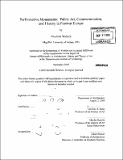| dc.contributor.advisor | Caroline A. Jones and Martha Buskirk. | en_US |
| dc.contributor.author | Widrich, Mechtild. | en_US |
| dc.contributor.other | Massachusetts Institute of Technology. Dept. of Architecture. | en_US |
| dc.date.accessioned | 2010-04-28T17:00:50Z | |
| dc.date.available | 2010-04-28T17:00:50Z | |
| dc.date.copyright | 2009 | en_US |
| dc.date.issued | 2009 | en_US |
| dc.identifier.uri | http://hdl.handle.net/1721.1/54554 | |
| dc.description | Thesis (Ph. D.)--Massachusetts Institute of Technology, Dept. of Architecture, 2009. | en_US |
| dc.description | Cataloged from PDF version of thesis. | en_US |
| dc.description | Includes bibliographical references (p. 343-364). | en_US |
| dc.description.abstract | The performative monument, as I term an emergent genre of interactive public actions, rests on a new notion of agency in public space, in which political responsibility is performed by historically aware individuals in acts of commemoration. This dissertation argues that public performance art starting in the 1960s provided a crucial impulse for new forms of commemoration in 1980s Europe and beyond. I claim that performance, a supposed antipode to the monument in its ephemerality and dematerialization, did not neutralize the monumental but reinvented it as a new practice: one that involved the audience explicitly through conventional transactions, best understood through the speech-act theory of J. L. Austin (who coined the term "performative" in the 1950s). To specify the correlation between performance and monumental public space, I draw attention to the empirical shift from performance to monument production in the work of postwar Central and Eastern European artists, and to the theoretical continuity that makes this shift possible. Monumental architecture played a role in the early performances of Anselm Kiefer, Joseph Beuys, Jochen Gerz (all German), Valie Export, Peter Weibel, and Giinter Brus (Austrians), Marina Abramovid and Braco Dimitrijevid (from former Yugoslavia), among others. These artists brought a performative component to the memorial culture of the 1980s and '90s, mediating between history and the individual in ways sketched by the ephemeral events of '60s and '70s performance. | en_US |
| dc.description.abstract | (cont.) I examine these interconnections in the passage from confrontation to commemoration through a variety of heterogeneous but related documents: photographs and eyewitness accounts of early performance; interviews and press accounts that evolved their own logic and myths over the years separate from the events; plans and drawings of unrealized monuments, and that most complicated and characteristic form of 'performative documentation,' photographs modified through drawing, painting, or collage techniques to involve their viewers in a collaborative re-imagining of the role of commemoration in public space. | en_US |
| dc.description.statementofresponsibility | by Mechtild Widrich. | en_US |
| dc.format.extent | 364 p. | en_US |
| dc.language.iso | eng | en_US |
| dc.publisher | Massachusetts Institute of Technology | en_US |
| dc.rights | M.I.T. theses are protected by
copyright. They may be viewed from this source for any purpose, but
reproduction or distribution in any format is prohibited without written
permission. See provided URL for inquiries about permission. | en_US |
| dc.rights.uri | http://dspace.mit.edu/handle/1721.1/7582 | en_US |
| dc.subject | Architecture. | en_US |
| dc.title | Performative monuments : public art, commemoration, and history in postwar Europe | en_US |
| dc.title.alternative | Public art, commemoration, and history in postwar Europe | en_US |
| dc.type | Thesis | en_US |
| dc.description.degree | Ph.D. | en_US |
| dc.contributor.department | Massachusetts Institute of Technology. Department of Architecture | |
| dc.identifier.oclc | 567444152 | en_US |
